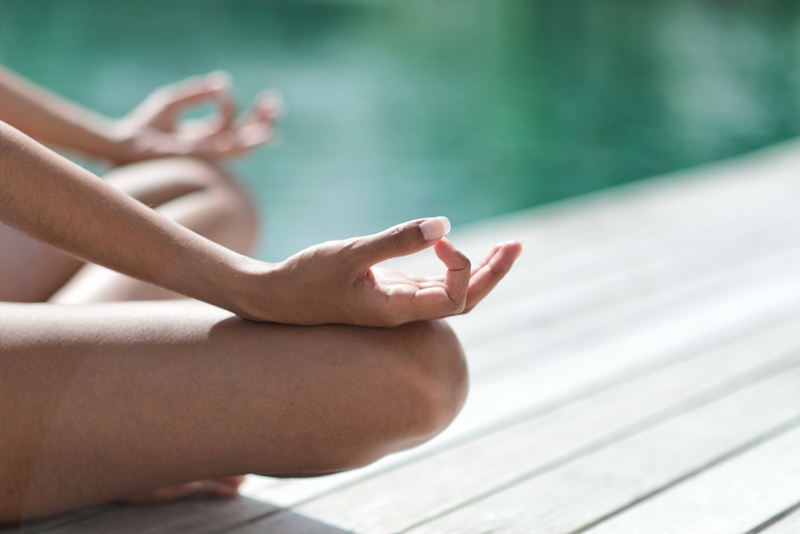In our fast-paced world, it's no wonder so many of us deal with racing thoughts. Wouldn't it be great if we could just slow down our minds sometimes? With meditation, we can.
Read on to learn what meditation is, the benefits and how you can add it to your life:
What is meditation?
Meditation is when you quiet distracting thoughts and try to live in the moment. It's commonly practiced by being still and attempting to calm your mind. The aim of meditation is to simply exist in the present. When worries, anxieties or nagging reminders of tasks on your to-do list enter your mind, you let them pass instead of dwelling on them. Instead, you focus on your breathing and mood. Meditation is the practice of mindfulness, of fully living in the now.
 Meditation can help you live in the moment.
Meditation can help you live in the moment.
What types of meditation are there?
There are many different types of meditation, including transcendental, the Buddhism-based vipassana and qi gong, a Taoist type of meditation, as The Huffington Post Canada explained. The various types may involve special breathing practices, mantras or movements but they all centre on focusing the mind and finding inner peace. Meditation can also be incorporated into different yoga practices.
What are the benefits of meditation?
Research shows important benefits for both mental and physical health.
Meditation can reduce anxiety and depression and can help ease symptoms of hypertension and type 2 diabetes, according to Best Health Magazine.
Meditation can even change the neural pathways in our brains. The source cited a study that took brain scans of Tibetan monks who consistently meditated and found that the monks' brains had a higher level of activity in the pathways responsible for positive feelings and concentration.
In an article for The Globe & Mail, author Reva Seth cited studies that showed the health benefits of meditation. An article published in the Journal of Health Psychology found meditation lowers levels of cortisol, a type of stress hormone, in the body.
Other wellness benefits include improved sleep and less severe headaches, according to The Huffington Post Canada.
Seth believes that this research shows meditation should be a regular part of people's health and wellness routines.
"From a public-health perspective, Canada should be experimenting and implementing what research suggests is a cost-effective, non-invasive means of helping to address our national mental-health crisis," she wrote.
When dealing with a stressful day, meditating can ease anxiety. When practiced regularly, meditation can help you develop a more positive, healthier way of thinking.
How to add meditation to your life
Meditation is an accessible practice because it can be done anywhere, anytime, without any equipment and by people of all mobility levels.
There are many ways that you can add meditation to your life. Here are some ideas:
In the morning: Meditating in the morning helps you start your day off on the right foot. If you practice every day, it can quickly and easily become part of your getting-ready routine. If you're not a morning person, you could meditate before you go to bed as part of your wind-down ritual.
Through yoga: Yoga is a wellness practice that also has great mental and physical health benefits. You can do simple yoga practices that focus on slow, steady breathing, which is an important aspect of meditation. For more information, check out our blog post, "What's the Deal with Yoga?"
At work: Work is one of the biggest sources of stress and anxiety for many people. On your lunch or coffee break, meditate for 5-10 minutes. Your office may have wellness facilities where you can find a quiet room to reflect. If not, just sitting and meditating outside or in a nearby park can work wonders to give you a boost of energy and positive emotions.
"Be conscious of the speed of your breaths, taking in and letting out air slowly and steadily."
Tips for meditating
Find a quiet, calm space to meditate in, ideally free of distractions. If you need help calming your mind, you can listen to soothing music. Sitting with your legs crossed and your arms resting on your knees, palms facing upward, is a common meditation position, but you can sit in any way that is comfortable.
Close your eyes and breathe deeply. Be conscious of the speed of your breaths, taking in and letting out air slowly and steadily.
The most important thing is to not become frustrated with yourself! You're only human, and it's natural to have distracting thoughts. Simply let these thoughts pass and re-center yourself.
Start small with your meditation. Begin your practice by meditating for just a few minutes, and then work your way up to meditating for longer, if you wish.
Using meditation apps
There are many innovative smartphone apps on the market that can support your meditation practice. A few popular ones are:
- Headspace: Has a variety of guided sessions including those targeted to improving sleep and reducing stress, as well as "SOS exercises" that can help calm your mind in anxious moments that arise suddenly.
- The Mindfulness App: Designed to suit all levels of meditators, from first-timers to life practitioners. Includes silent, timed and guided sessions and a five-day introduction program to mindfulness.
- Calm: Features a diverse array of guided meditations, including those tailor-made for commutes. Focused on reducing anxiety, creating feelings of peace and improving sleep.
The benefits make it clear that meditation should be a part of every person's health and wellness routine. With these tips, you can get started on your meditation journey today.